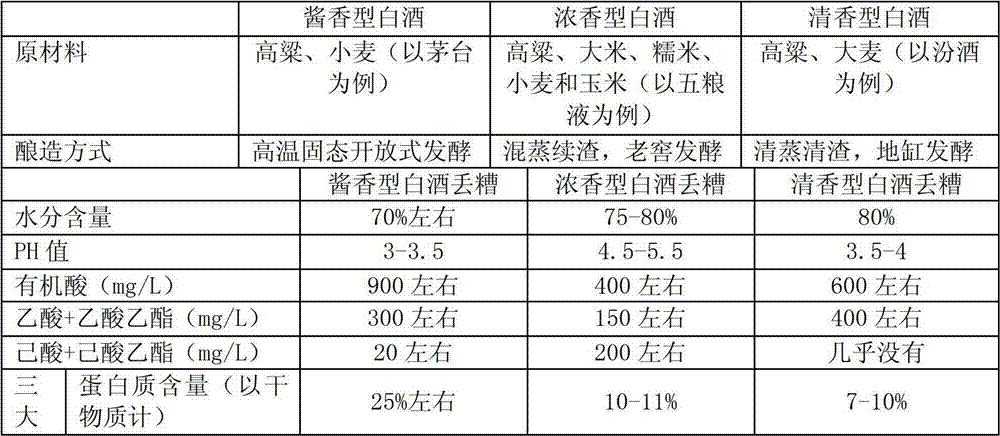Method for recycling spent grains of strong aromatic Chinese spirit by using fly larvae
A strong-flavor liquor, a resource-based technology, applied in climate change adaptation, fertilizers made from biological waste, organic fertilizers, etc., can solve problems such as high acidity, slow hatching of fly eggs, and different quality of distiller's grains
- Summary
- Abstract
- Description
- Claims
- Application Information
AI Technical Summary
Problems solved by technology
Method used
Image
Examples
Embodiment 1
[0049] Embodiment 1 of the present invention: The method for waste disposal of Luzhou-flavor type (such as Wuliangye) liquor with fly maggots as resources comprises the following steps:
[0050] (1) Collection of fly species and clean rearing and domestication: collect local wild houseflies, carry out biological identification according to Fan Zide's "Chinese Common Flies Index", place them in 80cm×30cm×30cm stainless steel wire clean insect breeding cages, adult flies with Raised with milk powder and brown sugar at a mass ratio of 1:1, the larvae were cultured cleanly with bran, the indoor temperature was 20°C-30°C, the relative humidity was 60%-80%, and the light rhythm was based on the local environment. Breed in about 65% wheat bran, collect 3rd instar larvae weighing ≥ 20 mg on the 5th day to pupate in 15% water bran, then select oval-shaped pupae about 6.0 mm in length and place them in clean breeding cages to emerge into flies. , Brown sugar breeding to lay eggs, and en...
Embodiment 2
[0057] Embodiment 2 of the present invention: fly maggot resources processing Luzhou-flavor liquor discarded grains method comprises the following steps:
[0058] (1) Collection of fly species and clean breeding and domestication: collect local wild houseflies, carry out biological identification according to Fan Zide's "Chinese Common Fly Index", and then follow the natural breeding environment of local houseflies (temperature around 25°C, humidity 70% left and right, light, etc.) conditions, the adult flies were fed with milk powder and brown sugar with a mass ratio of 1:1, and the larvae were bred with bran cleanly, and passed on naturally for more than 5 generations, so that they had stable reproductive characteristics in an intensive feeding environment.
[0059] (2) Transformation of Luzhou-flavor liquor discarded grains to adapt to the induction and stabilization of fly strains: use Luzhou-flavored liquor discarded grains to induce and cultivate the domesticated housefly...
Embodiment 3
[0065] Embodiment 3 of the present invention: the method for resourceful processing of Luzhou-flavor liquor discarded grains by fly maggots comprises the following steps:
[0066] (1) Collection of fly species and clean rearing and domestication: collect local wild houseflies for biological identification, then feed adult flies with milk powder and white sugar with a mass ratio of 1:1, clean and breed larvae with bran, and pass on naturally for more than 5 generations. It has stable reproductive characteristics in an intensive breeding environment.
[0067](2) Transformation of Luzhou-flavor liquor discarded grains to adapt to the induction and stabilization of fly strains: use Luzhou-flavored liquor discarded grains to induce and cultivate the domesticated housefly larvae after step (1), the ambient temperature is 20-30°C, and the relative humidity is 60% -80%; the water content of the inductive dregs discarding compost is 50%-80%, and its ratio is gradually increased from dr...
PUM
| Property | Measurement | Unit |
|---|---|---|
| water content | aaaaa | aaaaa |
Abstract
Description
Claims
Application Information
 Login to View More
Login to View More - R&D
- Intellectual Property
- Life Sciences
- Materials
- Tech Scout
- Unparalleled Data Quality
- Higher Quality Content
- 60% Fewer Hallucinations
Browse by: Latest US Patents, China's latest patents, Technical Efficacy Thesaurus, Application Domain, Technology Topic, Popular Technical Reports.
© 2025 PatSnap. All rights reserved.Legal|Privacy policy|Modern Slavery Act Transparency Statement|Sitemap|About US| Contact US: help@patsnap.com


